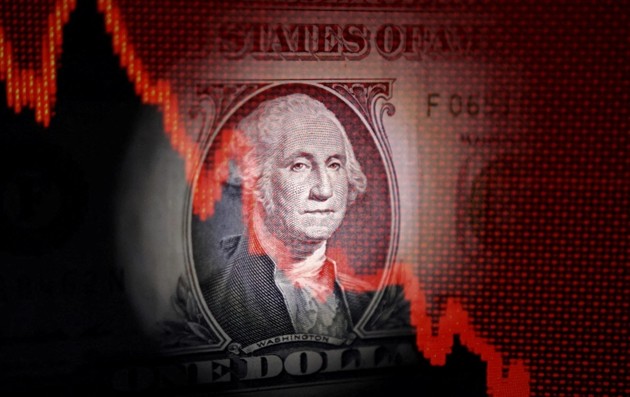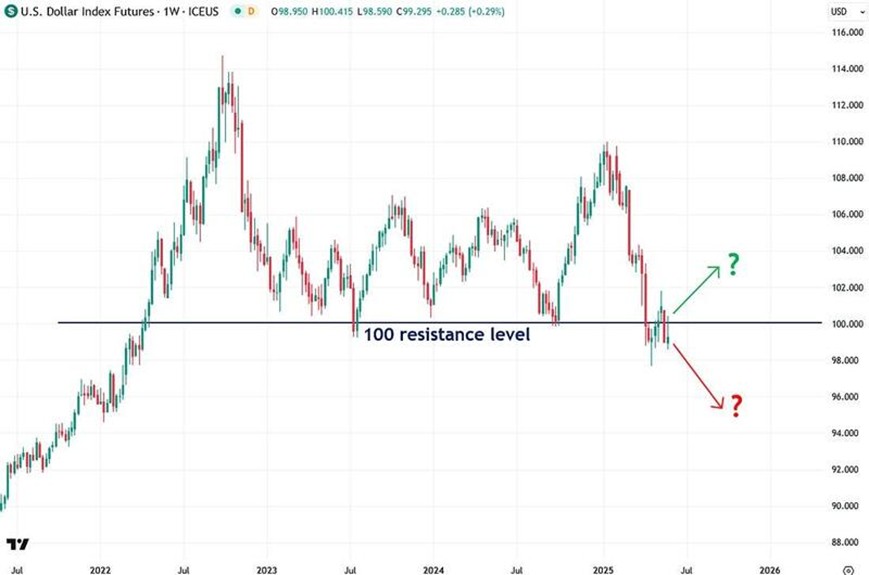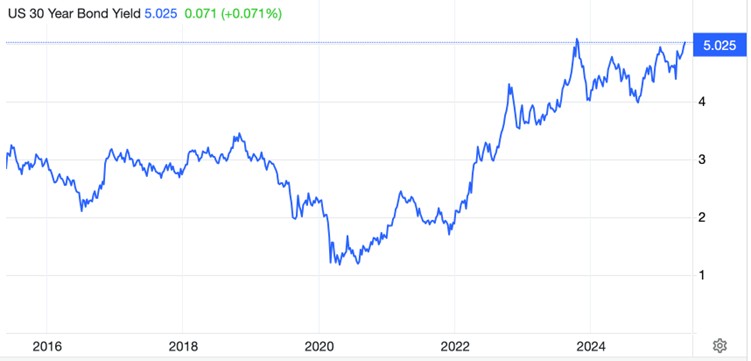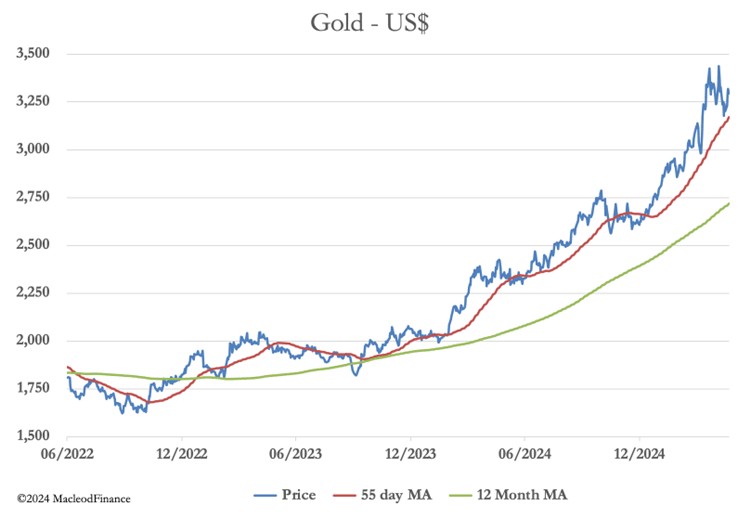The Truth About The USD And Where It’s Headed



Editorial Note: While we adhere to strict Editorial Integrity, this post may contain references to products from our partners. Here's an explanation for How We Make Money. None of the data and information on this webpage constitutes investment advice according to our Disclaimer.
While a total collapse of the US dollar is unlikely, its global dominance is weakening. Rising debt, higher interest rates, de-dollarization, and gold’s growing role in trade are key factors. The USD Index may drop further—Morgan Stanley predicts up to 10%—though policy shifts could still support a rebound.
So, how is the US dollar doing and what does the future of USD look like?
Well, USD is going to completely collapse…the US economy is going to completely collapse… the United States is going to go bankrupt…and the US will become just a relatively powerless colony of China.
Okay, not really – just kidding.

Here’s the thing…a complete collapse of the US dollar and the US economy would lead to a complete collapse of the global economy, and nobody wants that - not even China and Russia. The US is simply too important, too critical, an economic force in the world economy. And the oft-repeated adage among Forex traders remains pretty much true – “The US dollar is the most worthless currency in the world…except for all the other fiat currencies.” In short, and to put it bluntly, the dollar sucks…but it doesn’t suck as bad as, for example, the euro.
So, if you’re waiting for a total collapse, an extinction, of the US dollar, don’t hold your breath.
HOWEVER, a more likely scenario to unfold is one where the dominance of the US dollar as the world’s major reserve currency is diminished. USD will likely continue to occupy a position of prominence in the global economy, but its days of sitting head and shoulders, way above every other currency in the world in value, are, most probably, numbered.
Risk warning: Forex trading carries high risks, with potential losses including your entire deposit. Market fluctuations, economic instability, and geopolitical factors impact outcomes. Studies show that 70-80% of traders lose money. Consult a financial advisor before trading.
The US dollar is perched at a precarious technical support level
I must’ve read half a dozen or more variations of this statement – from several different market analysts – in just the past couple of days: “The US dollar is at a critical inflection point”.
The USD Index is currently sitting at around 99. That puts it down significantly from the peak around 110 that it reached early in 2025 and, perhaps more importantly, below the critical support level of 100. In case you’re not familiar with it, the USD Index reflects the value of the US dollar as measured against a basket of other currencies. It, typically, has an inverse relationship with commodity prices. A lower USD Index usually correlates with higher commodity prices. And, sure enough, a prime example of this is that while USD has been going down, the price of gold has been soaring ever higher.
The US Dollar Index

USD hasn’t been helped by the fact that Moody’s has downgraded US debt from AAA to AA1, nor by the fact that the Federal Reserve has had to step in at recent US Treasury auctions and buy billions of dollars in US securities that no other investors wanted. More “not good news” for the US dollar stems from the current situation where the US government is having to refinance trillions in debt that it originally secured at near zero interest rates at current interest rates now above 5%.
The yield on long-term US Treasuries

It wasn’t that long ago that the yield on 30-year US Treasuries was just above 1%. But, since 2022 – basically, in the space of just a couple of years – the yield has shot up to a level that’s nearly five times higher. Translation: The US is having to offer much higher yields in order to entice investors to buy long-term US bonds. Additionally, higher interest rates overall mean that the total US debt is becoming increasingly difficult to manage. Just making the interest payments on the national debt – which now total more than $1 trillion annually – is putting a substantial pinch on the US government’s finances.
Meanwhile, look at the movement of gold prices since 2022:

Notice a distinct difference in direction, as compared to US bond yields?
De-dollarization is driving the US dollar down
Another major factor exerting downward pressure on the value of the US dollar is the ever-widening push of de-dollarization. Ever since the US confiscated $300 million in Russian securities, Russia, China, the BRICS nations, and the countries that make up the Shanghai Cooperation Organization (SCO), have been moving to create an alternative international trade infrastructure where trades are settled in either local currencies or gold.
Gold is rapidly replacing the US dollar as the primary collateral asset in cross-border settlements between a growing number of countries. This is a monumental shift away from the situation that governed the previous 60-70 years, where virtually all international trading was conducted using US dollars.
China is already dropping hints of a return to the gold standard, with rumors of a gold-backed yuan possibly coming within just the next couple of years, one with gold pegged at around the $5,000 per ounce level. That’s quite a call with gold currently trading at just around $3,350 an ounce. But it’s a call that appears to reflect the opinions of many precious metals market analysts, who barely even bother to mention the prospect of gold hitting $4,000 an ounce – instead, just jumping straight ahead to forecasts of $5,000 an ounce, as if it were already a fait accompli. (That’s French for an action or circumstance considered to be as good as already accomplished – just in case you weren’t familiar with the term.)
It's as simple as this:
An increasing number of countries don’t want their treasury or their economy exposed to possible US financial sanctions – Nobody likes a bully, and the sad fact is that the US has increasingly become a financial bully in the world, essentially telling countries, “Do what we want or we’ll penalize you financially”.
It’s again an “increasing number of countries” that just isn’t all that enthusiastic about investing in the debt securities of a nation that’s $37 trillion in debt (It’s $37 trillion now, right? – seems like it was “only” $35 trillion just about 10 minutes ago.)
Conclusion
So, what’s the truth about the US dollar and where it’s likely to be headed in the future?
Well, the short version, in my not-so-humble opinion is – Gold (and silver!) up; US dollar down. A recent Morgan Stanley forecast sees the USD Index dropping by almost another 10% within the next year or so.
Allow me to elaborate just a bit more:
The hard truth for the US dollar is that its days of financial dominance in the world are, most likely, drawing to a close. In fact, with virtually all of the world’s major economies facing overhanging amounts of debt that they can’t ever hope to repay, we are likely lurching toward “the Great Monetary Reset”, which may well involve some sort of return to the gold standard… but that’s a discussion for another article.
The value of USD, relative to other major currencies, will probably continue to decline – so, look for the USD Index to continue falling, to levels that it hasn’t seen in recent years. A decline for the US dollar is really, at least in part, just a natural consequence of the emergence of a more global economy.
Let me close by being fair and gracious enough to note the alternative scenario. It’s possible that the USD Index could catch technical support here around the 100 level, the same level that has seen the halt of previous dollar downturns, and rebound to the upside. We have yet to see the long-term effects of President Trump’s second-term economic policies, and it’s entirely possible that they may bolster the overall US economy and, in turn, the dollar.
I don’t know which way the economic wind will blow here, but I strongly caution you against listening to the mainstream media’s never-ending pronouncements of economic doom and gloom for the US – that’s just the media’s standard anti-Trump propaganda. As long as Trump is President, they’d be spouting that crap even if the US economy were experiencing its biggest boom in history.
In any event, the US Dollar Index is a major market indicator that’s well worth traders paying attention to.
FAQs
Is USD more likely to be headed higher, or headed lower, over the next year?
While it’s impossible to predict the future with 100% accuracy, there appear to be significantly more downside, rather than upside, forces confronting USD at this time. These forces include global de-dollarization, rising interest rates, and the US government’s debt problem.
What are the main factors that determine the value of USD relative to other currencies?
Many different factors can influence where USD is headed. US interest rates, relative to prevailing interest rates in other countries, are always a significant factor in determining USD’s relative value. Another significant factor at the moment is the growing push toward de-dollarization – nations moving to reduce their exposure to USD.
What is the current technical analysis outlook for USD?
A primary technical analysis focus for many traders and market analysts is the USD Index. The Index has recently dropped below the key technical support level of 100, signaling a potential further decline in value for USD.
What is the likelihood of a major collapse of the US dollar?
While the US dollar may suffer a substantial decline, a total collapse of the dollar is considered unlikely. First, this is simply because the US dollar is so firmly entrenched in international trade. Second, the US economy is critical to the overall global economy – a serious collapse of the US currency would be likely to trigger a massive global economic crisis.
Related Articles
Team that worked on the article
Johnathan M. is a U.S.-based writer and investor, a contributor to the Traders Union website. His two primary areas of expertise include finance and investing (specifically, forex and commodity trading) and religion/spirituality/meditation.
His experience includes writing articles for Investopedia.com, being the head writer for the Steve Pomeranz Show, a personal finance radio program on NPR. Johnathan is also an active currency (forex) trader, with over 20 years of investing experience.
Chinmay Soni is a financial analyst with more than 5 years of experience in working with stocks, Forex, derivatives, and other assets. As a founder of a boutique research firm and an active researcher, he covers various industries and fields, providing insights backed by statistical data. He is also an educator in the field of finance and technology.
As an author for Traders Union, he contributes his deep analytical insights on various topics, taking into account various aspects.
Mirjan Hipolito is a journalist and news editor at Traders Union. She is an expert crypto writer with five years of experience in the financial markets. Her specialties are daily market news, price predictions, and Initial Coin Offerings (ICO).
CFD is a contract between an investor/trader and seller that demonstrates that the trader will need to pay the price difference between the current value of the asset and its value at the time of contract to the seller.
Cryptocurrency is a type of digital or virtual currency that relies on cryptography for security. Unlike traditional currencies issued by governments (fiat currencies), cryptocurrencies operate on decentralized networks, typically based on blockchain technology.
The yuan (CNY) is the official currency of the People's Republic of China. The yuan is divided into 10 jiao, which are further divided into 10 fen.
An investor is an individual, who invests money in an asset with the expectation that its value would appreciate in the future. The asset can be anything, including a bond, debenture, mutual fund, equity, gold, silver, exchange-traded funds (ETFs), and real-estate property.
The informal term "Forex Gods" refers to highly successful and renowned forex traders such as George Soros, Bruce Kovner, and Paul Tudor Jones, who have demonstrated exceptional skills and profitability in the forex markets.





























































































































